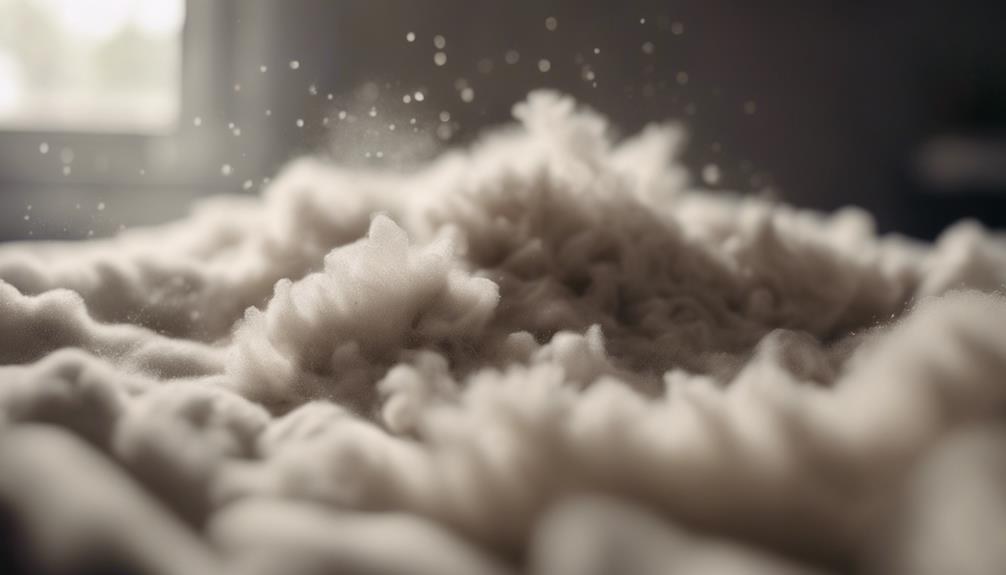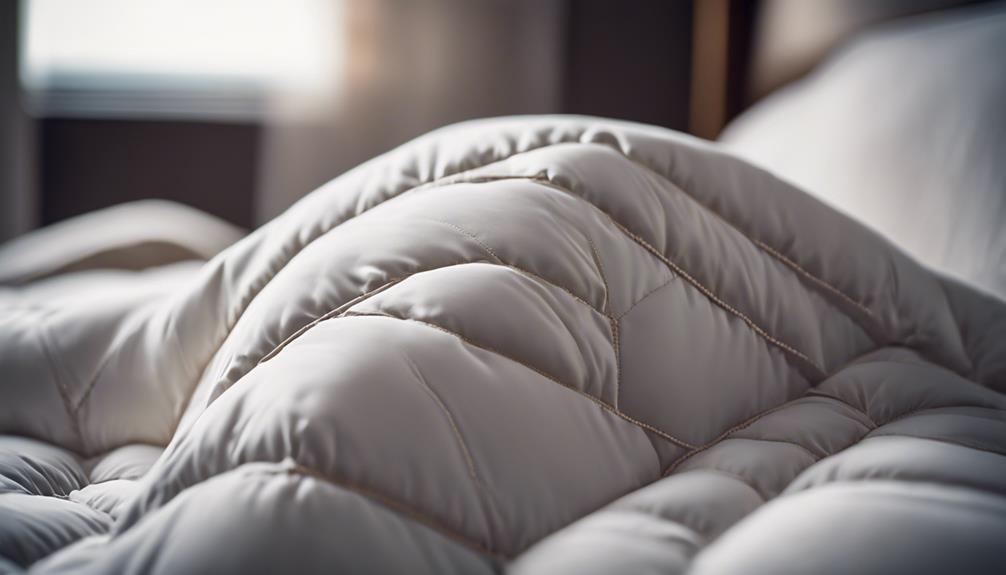Yes, down comforters do attract and trap dust over time, leading to potential allergy issues. Dust mites thrive in warm, humid environments like those in down comforters. Regularly shaking out and airing the comforter prevents dust buildup. Using a duvet cover provides an extra layer of defense against dust settling within the filling. Neglecting dust removal can trigger allergies, underscoring the importance of following washing instructions. Want to learn more about how dust impacts down comforters and allergies?
Key Takeaways
- Dust can accumulate on down comforters over time.
- Dust mites thrive in down comforters' environment.
- Regular shaking and airing out prevent dust buildup.
- Using a duvet cover adds protection against dust.
- Neglecting dust removal can cause allergies.
Dust Accumulation on Down Comforters

Down comforters can attract and retain dust particles over time, impacting their cleanliness and potentially affecting comfort levels. Dust mites, which thrive in warm and humid environments, can also make a home in down comforters.
To prevent dust accumulation, it's essential to make sure to regularly shake out and air the comforter. Additionally, using a duvet cover adds a protective layer that can deter dust from settling within the clusters of down filling.
When dust is left unchecked, it can lead to allergic reactions for sensitive individuals who may be affected by dust mites. To maintain a clean and dust-free down comforter, make sure to follow the manufacturer's instructions for washing and drying. Proper care not only removes dust but also helps in preserving the overall quality and comfort of the comforter for a longer period.
Impact of Dust on Allergies
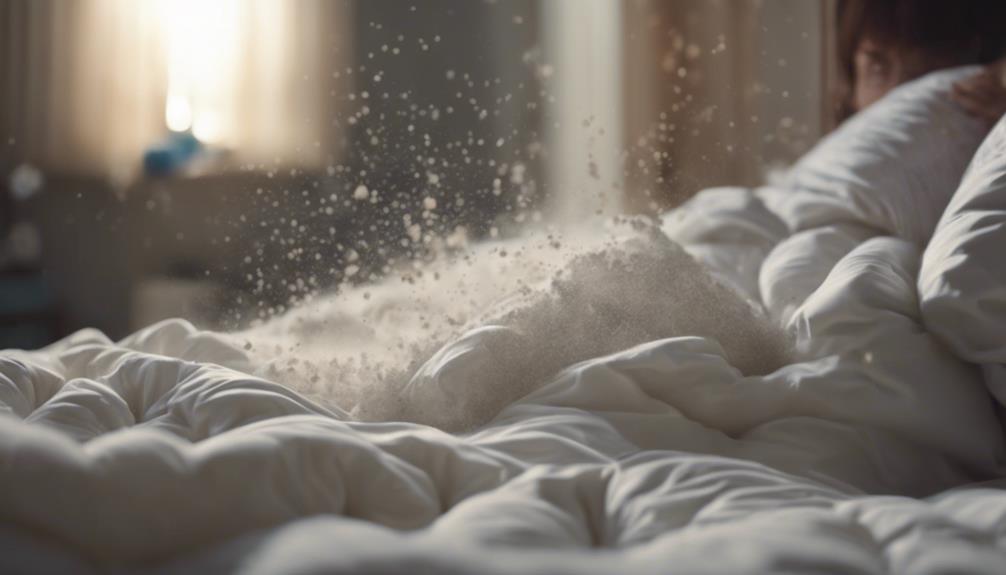
Exposure to dust in bedding can greatly worsen allergy symptoms, including sneezing, coughing, and itching. Dust, containing common allergens like dust mites, pet dander, and skin flakes, can trigger allergic reactions in sensitive individuals. These allergens are among the top culprits for causing discomfort and respiratory issues in people prone to allergies.
When dust accumulates in down comforters, it creates an environment where these allergens thrive, making it essential to address dust buildup to alleviate allergy symptoms. Regular washing and maintenance of down comforters can help reduce dust levels and minimize exposure to these top allergens, providing relief for allergy sufferers.
Additionally, encasing down comforters in allergen-proof covers serves as a protective barrier, preventing dust mites and other irritants from coming into direct contact with individuals during sleep. By understanding the impact of dust on allergies and taking proactive measures to minimize exposure, individuals can create a more comfortable and healthier sleeping environment.
Strategies to Minimize Dust Buildup

To minimize dust buildup on down comforters, it's essential to establish a regular dusting routine and opt for bedding materials that are less prone to accumulating dust. By choosing hypoallergenic materials and regularly shaking out and airing the comforter, you can reduce the risk of dust mites and allergens.
Additionally, considering the use of duvet covers as an extra protective layer can help in maintaining a cleaner sleeping environment.
Dusting Frequency Tips
How often should we dust our living spaces to minimize dust buildup effectively? Here are some tips to help keep dust at bay:
- Establish a Routine: Dusting once a week can help prevent dust from accumulating on surfaces.
- Use Microfiber Cloths: These cloths are effective at trapping dust particles and can be used for both dry and damp dusting.
- Clean Air Vents and Filters: Regularly dusting air vents and replacing filters can reduce the amount of dust circulating in the air.
- Declutter: Minimize the number of items in your living space as clutter can attract and trap dust.
Bedding Material Choices
When considering bedding material choices to minimize dust buildup, prioritizing down comforters with hypoallergenic properties or allergen-proof covers can be an effective strategy. These options help reduce the likelihood of dust mites inhabiting the comforter and accumulating dust over time. Additionally, regular shaking and fluffing, using a duvet cover that is washed frequently, and vacuuming the surrounding area can further prevent dust from settling on the comforter. Rotating the comforter also aids in minimizing dust accumulation. By incorporating these practices and selecting suitable bedding materials, such as hypoallergenic down comforters or those with allergen-proof covers, individuals can create a cleaner sleeping environment with reduced dust exposure.
| Strategies to Minimize Dust Buildup |
|---|
| Prioritize hypoallergenic down comforters |
| Use allergen-proof covers |
| Regularly shake and fluff the comforter |
| Wash duvet covers frequently |
Importance of Regular Cleaning
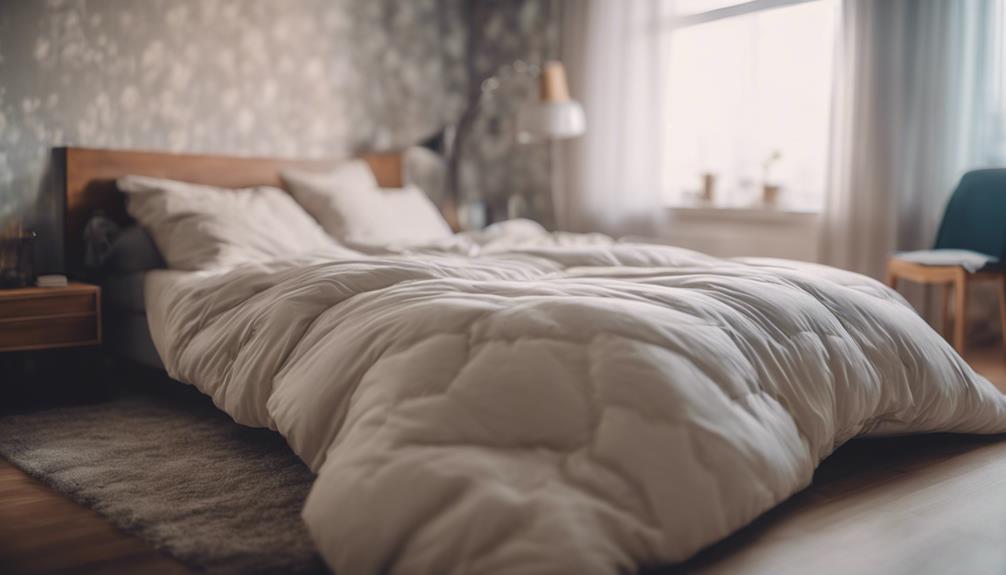
Regular cleaning of down comforters is important to prevent dust mite allergies and maintain indoor air quality. To reduce dust accumulation, washing and fluffing the comforter regularly are essential maintenance tips.
Additionally, vacuuming around the bed can help minimize dust particles that settle on the comforter.
Dust Mite Allergies
Discussing the importance of regular cleaning in managing dust mite allergies involves implementing consistent maintenance practices to reduce allergen exposure. Dust mites, microscopic creatures found in bedding, feed on shed skin cells and their feces contain allergens that can trigger reactions in sensitive individuals.
To minimize these allergic responses, consider the following:
- Wash and dry down comforters at high temperatures to eliminate dust mites.
- Encase down comforters in allergen-proof covers to create a barrier against dust mites.
- Vacuum and dust the bedroom regularly to prevent dust mite buildup.
- Wash bedding weekly to further reduce allergen exposure and alleviate allergy symptoms.
Maintenance Tips
Implementing consistent maintenance practices is vital for ensuring the cleanliness and longevity of down comforters. Regular cleaning helps prevent dust and allergen buildup, which can lead to respiratory issues, especially for sensitive individuals. Washing and drying down comforters following the manufacturer's instructions is essential in reducing dust accumulation. Additionally, vacuuming the surrounding area and using allergen-proof covers can further minimize dust exposure from the comforter. Below are some key maintenance tips to keep your down comforter in top condition:
| Maintenance Tips | Description |
|---|---|
| Follow care instructions | Wash and dry the comforter according to manufacturer's guidelines to reduce dust buildup. |
| Vacuum regularly | Vacuum the area around the bed to minimize dust accumulation that can transfer to the comforter. |
| Use allergen-proof covers | Covering the comforter with allergen-proof materials can help prevent dust from settling in it. |
Benefits of Using Duvet Covers
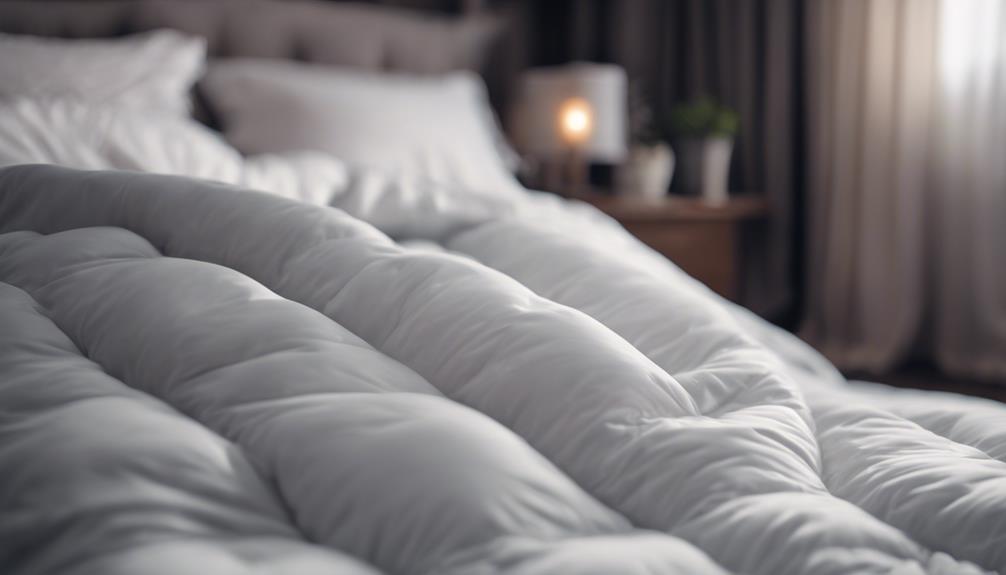
Using a duvet cover provides a practical solution for maintaining the cleanliness and longevity of your down comforter. Here are four key benefits of using duvet covers:
- Protective Barrier: Duvet covers act as a shield, preventing down feathers from escaping the comforter. This containment helps to reduce the amount of dust and allergens that can accumulate in your bedding.
- Preserving Quality: By using a duvet cover, you can lessen the need for frequent washing of the down comforter itself. This helps preserve the quality of the comforter over time, as excessive washing can cause the down to clump or lose its loft.
- Customization and Easy Cleaning: Duvet covers come in various styles, colors, and materials, allowing you to personalize your bedding to suit your taste. Additionally, they're easily removable and machine washable, making cleaning and changing the look of your bedding a breeze.
- Enhanced Aesthetic Appeal: Investing in a high-quality duvet cover not only keeps your comforter clean but also enhances the overall aesthetic of your bedroom. The right duvet cover can add a touch of style and sophistication to your sleep space.
Manufacturer Care Instructions for Dust Prevention
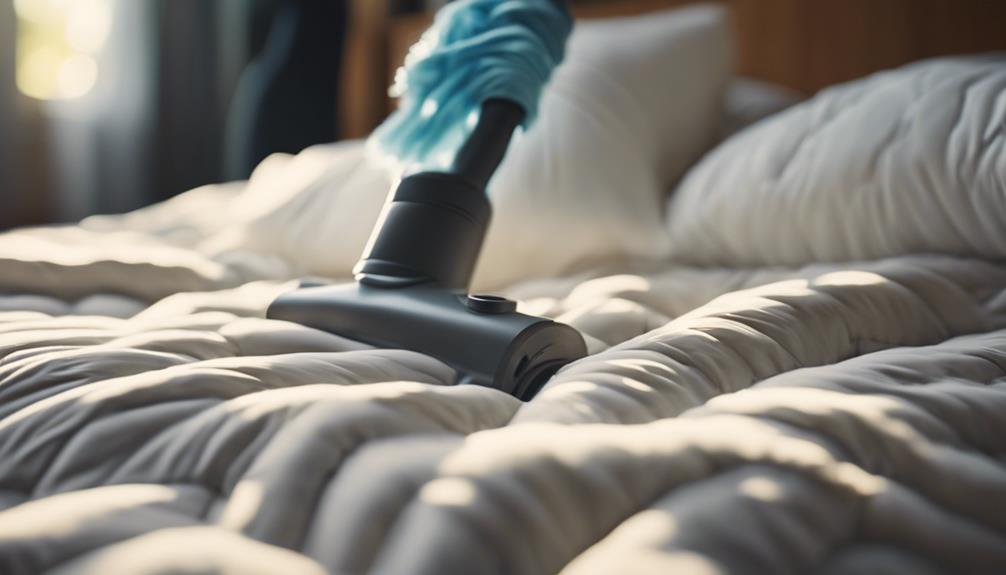
To prevent dust accumulation on your down comforter, it's important to follow the care instructions provided by the manufacturer. Regular washing, as recommended by the manufacturer, can help prevent dust buildup. Proper storage of the down comforter when not in use is also vital in minimizing dust accumulation.
Additionally, using a duvet cover can provide an extra layer of protection, keeping dust away from the comforter itself. It's essential to choose a high-quality down comforter with tightly woven fabric, as this can help reduce the penetration of dust particles. Following these care instructions diligently won't only maintain the quality of your down comforter but also prevent dust-related issues.
Proper ventilation and occasionally airing out the comforter can further aid in reducing dust accumulation. By following these manufacturer care instructions, you can ensure that your down comforter remains clean, fresh, and free from excessive dust.
Airing Out Down Comforters to Reduce Dust

Regularly airing out down comforters can greatly reduce dust accumulation and keep the bedding fresh and clean. Here are four simple steps to effectively air out your down comforter:
- Hang It Outside: Find a well-ventilated area outside where you can hang your comforter. Allowing it to breathe in the fresh air will help eliminate trapped dust particles.
- Sunlight Exposure: Hang your down comforter in direct sunlight. The UV rays can act as a natural disinfectant, reducing dust and giving your bedding a fresher smell.
- Shake It Out: Give your comforter a gentle shake or fluff while it's hanging outside. This action can help dislodge dust and debris that may have settled within the down clusters.
- Repeat Regularly: Make airing out your down comforter a routine. Proper ventilation and sunlight exposure are key to minimizing dust accumulation and keeping your bedding clean and fresh.
Frequently Asked Questions
Do Down Comforters Collect Dust Mites?
Yes, down comforters can collect dust mites if not washed frequently.
Dust mites, tiny pests thriving in warmth and humidity, feed on skin flakes and trigger allergies.
Regular washing and drying, using allergen-proof covers, and vacuuming can help control dust mite populations.
Keeping bedding clean is essential to reducing dust mites, ensuring a healthier environment for all.
Regular maintenance is vital to preventing dust mite buildup in down comforters.
Are Down Duvets Bad for Dust Allergies?
Down duvets can exacerbate dust allergies due to dust mites and dander they trap. To reduce symptoms like sneezing, coughing, and respiratory issues, regular washing is important. Hypoallergenic covers can help minimize dust exposure. Those with allergies may opt for synthetic fills or wool bedding.
Maintaining down duvets is vital for a healthier sleep environment. Promote better sleep by minimizing dust and allergens in your bedding.
How Do You Keep a Down Comforter Clean?
To keep a down comforter clean, regularly fluff and air it out. Use a duvet cover for protection and spot clean spills promptly. Follow the manufacturer's care instructions for washing and drying.
Consider professional cleaning services for deep maintenance. These steps will help maintain the cleanliness and longevity of your down comforter.
How Do You Clean Down Comforter Dust Mites?
To clean down comforter dust mites effectively, start by washing the comforter in hot water. This step helps eliminate dust mites.
Then, use a dryer on high heat to kill any remaining mites.
Vacuum the comforter with a HEPA filter to reduce dust mites further.
Regular cleaning is essential for managing allergens.
These steps keep your down comforter clean and free of dust mites, promoting better sleep and comfort.
Will Using Space Bags on Comforters Create Dust?
Using space bags on comforters can actually help reduce the amount of dust that accumulates on them. By sealing the comforters in airtight space bags, it prevents dust from settling on the fabric. This can be especially helpful for those with allergies or asthma who are sensitive to dust.
Conclusion
To sum up, while down comforters can attract dust, there are practical ways to minimize buildup and maintain a clean sleeping environment. Regular cleaning, using duvet covers, following manufacturer care instructions, and airing out the comforter can all help reduce dust accumulation.
By taking these simple steps, you can guarantee a comfortable and allergen-free sleeping experience. So, don't let dust be a concern when it comes to enjoying the cozy warmth of your down comforter.
